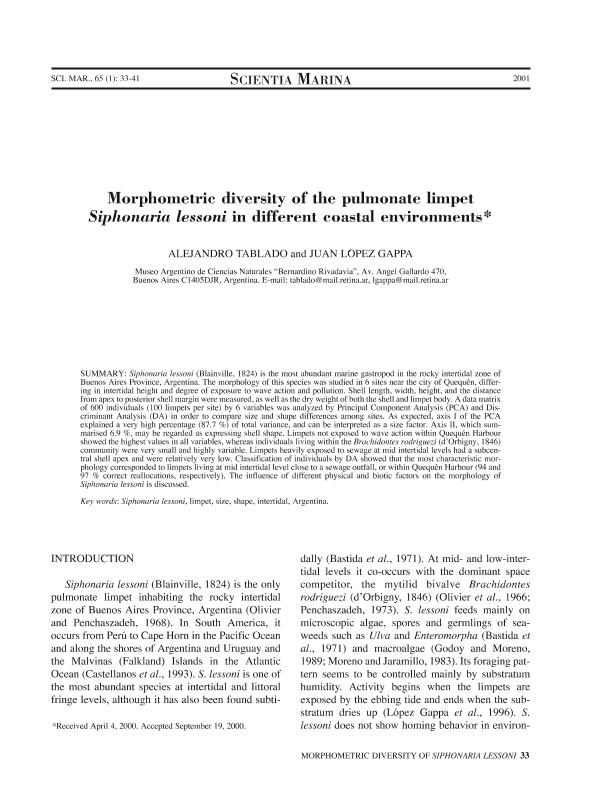Artículo
Morphometric diversity of the pulmonate limpet Siphonaria lessoni in different coastal environments
Fecha de publicación:
03/2001
Editorial:
Instituto de Ciencias del Mar Barcelona
Revista:
Scientia Marina
ISSN:
0214-8358
e-ISSN:
1886-8134
Idioma:
Inglés
Tipo de recurso:
Artículo publicado
Clasificación temática:
Resumen
Siphonaria lessoni (Blainville, 1824) is the most abundant marine gastropod in the rocky intertidal zone of Buenos Aires Province, Argentina. The morphology of this species was studied in 6 sites near the city of Quequén, differing in intertidal height and degree of exposure to wave action and pollution. Shell length, width, height, and the distance from apex to posterior shell margin were measured, as well as the dry weight of both the shell and limpet body. A data matrix of 600 individuals (100 limpets per site) by 6 variables was analyzed by Principal Component Analysis (PCA) and Discriminant Analysis (DA) in order to compare size and shape differences among sites. As expected, axis I of the PCA explained a very high percentage (87.7%) of total variance, and can be interpreted as a size factor. Axis II, which summarised 6.9 %, may be regarded as expressing shell shape. Limpets not exposed to wave action within Quequén Harbour showed the highest values in all variables, whereas individuals living within the Brachidontes rodriguezi (d'Orbigny, 1846) community were very small and highly variable. Limpets heavily exposed to sewage at mid intertidal levels had a subcentral shell apex and were relatively very low. Classification of individuals by DA showed that the most characteristic morphology corresponded to limpets living at mid intertidal level close to a sewage outfall, or within Quequén Harbour (94 and 97 % correct reallocations, respectively). The influence of different physical and biotic factors on the morphology of Siphonaria lessoni is discussed.
Palabras clave:
ARGENTINA
,
INTERTIDAL
,
LIMPET
,
SHAPE
,
SIPHONARIA LESSONI
,
SIZE
Archivos asociados
Licencia
Identificadores
Colecciones
Articulos(MACNBR)
Articulos de MUSEO ARG.DE CS.NAT "BERNARDINO RIVADAVIA"
Articulos de MUSEO ARG.DE CS.NAT "BERNARDINO RIVADAVIA"
Citación
Tablado, Alejandro; López Gappa, Juan José; Morphometric diversity of the pulmonate limpet Siphonaria lessoni in different coastal environments; Instituto de Ciencias del Mar Barcelona; Scientia Marina; 65; 1; 3-2001; 33-41
Compartir
Altmétricas




